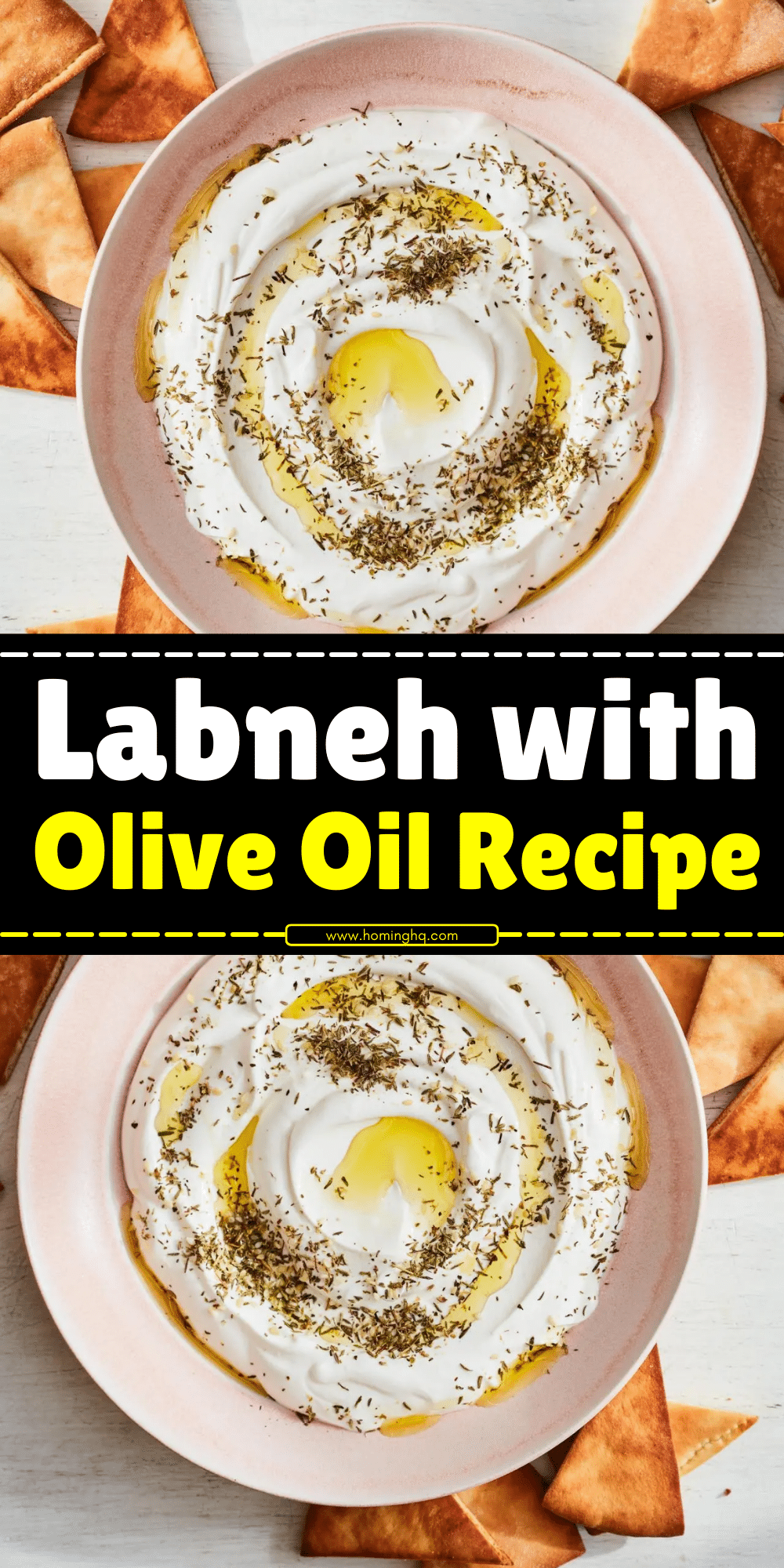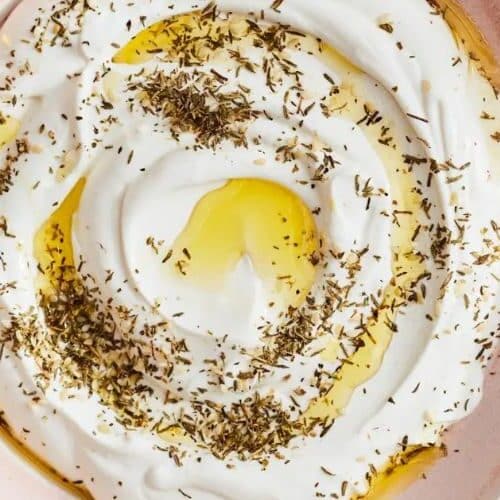Labneh is a traditional Middle Eastern strained yogurt that has gained popularity for its creamy texture, tangy flavor, and versatility in various dishes. It’s a staple in Mediterranean cuisine, often used as a dip, spread, or part of a larger dish.
This simple yet flavorful product has a rich history and is loved for its fresh, velvety mouthfeel that makes it a perfect complement to breads, vegetables, and even meats.
In this article, we’ll explore what labneh is, its health benefits, and how you can incorporate it into your daily meals.

What is Labneh?
Labneh is essentially a yogurt that has been strained to remove excess liquid, resulting in a thick, creamy consistency similar to cheese.
The process of straining removes the whey, which gives labneh its dense texture and rich flavor.
It can be made from both cow’s and goat’s milk, though the taste may vary slightly depending on the milk used.
Labneh is often seasoned with olive oil, salt, and sometimes herbs, making it both a tangy and savory treat. It’s commonly served as part of a mezze platter alongside hummus, baba ganoush, or fresh vegetables.
The richness of labneh makes it a delicious alternative to cream cheese or sour cream, with the added benefit of being a healthier option due to its probiotic content.
Health Benefits of Labneh
Labneh is not just a tasty addition to your meals—it also comes with a number of health benefits, thanks to its high nutritional value and probiotic content.
Rich in Protein
Labneh contains a high amount of protein, which is essential for muscle growth, tissue repair, and overall bodily function. This makes it a great option for people looking to increase their protein intake, especially for those on plant-based diets.
Packed with Probiotics
The straining process of labneh enhances its probiotic content. Probiotics are beneficial bacteria that promote gut health by improving digestion, boosting immunity, and balancing the intestinal flora. Consuming labneh regularly can help maintain a healthy digestive system.
Low in Lactose
Since much of the whey is removed during the straining process, labneh tends to be lower in lactose than regular yogurt. This makes it more tolerable for individuals who are lactose-sensitive, though the exact tolerance level can vary from person to person.
High in Healthy Fats
Labneh is often made with full-fat yogurt, which provides healthy fats that support brain health and help maintain a balanced diet. These fats are also essential for absorbing fat-soluble vitamins like A, D, E, and K.
Rich in Calcium
Like most dairy products, labneh is a good source of calcium, which is important for maintaining strong bones and teeth. Regular consumption of labneh can help ensure you’re meeting your daily calcium needs, especially if you have limited dairy intake in other areas of your diet.
What You Need to Make Labneh with Olive Oil
Making labneh at home is simple, and you only need a few basic ingredients and tools. Below is a list of what you’ll need to get started:
Ingredients
- Whole Milk Yogurt – You’ll need a good-quality, plain, full-fat yogurt as the base. The milk used in the yogurt will impact the texture and taste of the labneh, so opt for yogurt made from whole milk for the creamiest result.
- Salt – A pinch of salt will help enhance the flavor of the labneh. You can adjust the amount according to your taste preference.
- Olive Oil – High-quality extra virgin olive oil is essential for the finishing touch, giving the labneh a rich flavor. It’s often drizzled on top before serving, adding depth and a slight fruitiness.
Tools
- Cheesecloth or Muslin Cloth – To strain the yogurt and remove excess liquid (whey), you’ll need a cheesecloth or a clean muslin cloth. This is essential for achieving the thick, creamy consistency of labneh.
- Strainer – You’ll need a fine-mesh strainer to hold the cheesecloth and let the whey drain properly.
- Large Bowl – A large bowl will catch the draining whey as you strain the yogurt.
- Storage Container – Once the labneh is made, store it in an airtight container in the fridge.
How to Make Labneh

Making labneh at home is a straightforward process that only requires patience for the straining part. Here’s a step-by-step guide to help you create your own labneh with olive oil:
Step 1: Prepare the Yogurt
Start by placing your yogurt in a large bowl. Add a pinch of salt to the yogurt and mix it well, ensuring the salt is evenly distributed. This will enhance the flavor and prevent the labneh from being bland.
Step 2: Set Up the Straining Station
Next, lay a piece of cheesecloth or muslin cloth over a fine-mesh strainer. Place the strainer over a large bowl, ensuring there is enough space between the strainer and the bowl for the whey to drain.
Step 3: Strain the Yogurt
Spoon the salted yogurt into the cheesecloth-lined strainer. Once the yogurt is in place, gather the edges of the cloth and tie them together, securing it into a pouch. Allow the yogurt to drain for 12-24 hours in the refrigerator. The longer you strain it, the thicker your labneh will be. For a spreadable consistency, 12 hours is usually enough, but for a firmer result, let it strain for a full day.
Step 4: Transfer to a Container
After the yogurt has strained to your desired consistency, transfer the thickened labneh into a clean container. Drizzle some extra virgin olive oil over the top, and optionally, sprinkle with herbs like thyme or za’atar for added flavor. Seal the container and store it in the fridge until you’re ready to enjoy.
Step 5: Serve and Enjoy!
Labneh is incredibly versatile. You can serve it with fresh pita, raw vegetables, or as part of a mezze platter. Its tangy, creamy texture pairs beautifully with a variety of savory dishes. Drizzle more olive oil on top for a richer flavor and garnish with your favorite spices for extra flair.
Serving Labneh with Olive Oil
Labneh with olive oil is a versatile and delicious addition to many dishes. Its creamy, tangy texture makes it a perfect complement to a variety of meals, whether you’re looking for an appetizer, side dish, or snack. Here’s how you can serve labneh with olive oil:
As a Dip
Labneh makes a fantastic dip for fresh pita bread, crispy crackers, or raw vegetables like cucumbers, carrots, and bell peppers. Simply scoop the labneh into a shallow dish, drizzle with olive oil, and sprinkle with a pinch of salt or your favorite herbs such as thyme or za’atar. This simple combination is both satisfying and packed with flavor.
As a Spread
You can spread labneh on toast, bagels, or croissants as a creamy and healthier alternative to butter or cream cheese. Add a drizzle of olive oil, and top with sliced tomatoes, olives, or even a few crushed nuts for added texture and flavor.
As a Sauce for Grilled Meats or Vegetables
Labneh also works wonderfully as a sauce or dressing for grilled meats, like lamb or chicken, and roasted vegetables. Its richness complements smoky, savory flavors beautifully. Drizzle the labneh over the grilled items and finish with a bit more olive oil and fresh herbs.
On a Mezze Platter
Labneh is often served as part of a mezze platter alongside other Middle Eastern staples like hummus, baba ganoush, and tabbouleh. The olive oil drizzle adds richness, and you can add a variety of garnishes like pomegranate seeds, chopped mint, or garlic to create a visually stunning and flavor-packed dish.
Conclusion
Labneh with olive oil is a simple yet flavorful addition to your culinary repertoire. Whether you use it as a dip, spread, or sauce, this creamy yogurt-based delight brings both taste and health benefits to your table. The tangy richness of labneh, paired with the fruity depth of olive oil, offers a satisfying and versatile option for countless dishes. Its health advantages—from probiotics to protein—further elevate its value as a staple in any kitchen.
With its ease of preparation and wide range of serving options, labneh is a perfect way to enjoy Middle Eastern cuisine at home. Try it today and discover how this delicious treat can enhance your meals!
Frequently Asked Questions
1. Can I use low-fat yogurt to make labneh?
Yes, you can use low-fat yogurt to make labneh, but the texture and richness will be different. Labneh made from whole milk yogurt tends to be creamier and thicker, while low-fat versions might result in a lighter consistency.
2. How long can I store homemade labneh?
Homemade labneh can be stored in an airtight container in the fridge for up to 1-2 weeks. It should remain fresh and flavorful, especially if you’ve drizzled it with olive oil to preserve its moisture.
3. Can I add flavors to labneh while it strains?
Absolutely! You can add flavors to the yogurt before straining, such as garlic, herbs, or spices like cumin or paprika. This will infuse the labneh with additional flavors during the straining process, giving it a unique twist.
4. Can labneh be made with dairy-free yogurt?
Yes, you can make labneh with dairy-free yogurt made from almond, coconut, or soy milk. The texture may be slightly different, and the taste might vary depending on the type of non-dairy yogurt used, but the process remains the same.
5. How thick should the labneh be after straining?
The thickness of labneh depends on how long you strain it. After 12-24 hours of straining, labneh should be thick enough to hold its shape but still spreadable. If it’s too thick for your liking, you can stir in a small amount of the strained whey to reach your desired consistency.

Labneh with Olive Oil
Equipment
- 1 Cheesecloth or Muslin Cloth
- 1 Fine-Mesh Strainer
- 1 Large Bowl
- 1 Storage Container (airtight)
- 1 Spoon for mixing
Ingredients
- 2 cups Whole Milk Yogurt
- 1/2 teaspoon Salt adjust to taste
- 1/4 cup Extra Virgin Olive Oil
- Optional: Fresh herbs thyme, za’atar, garlic, or pomegranate seeds for garnish
Instructions
Prepare the Yogurt:
- Spoon the yogurt into a large mixing bowl. Add the salt and stir until well-combined.
Set Up for Straining:
- Place a fine-mesh strainer over a large bowl and line it with cheesecloth or muslin cloth.
Strain the Yogurt:
- Pour the salted yogurt into the cheesecloth-lined strainer. Gather the edges of the cloth and tie it into a pouch. Allow the yogurt to drain for 12-24 hours in the fridge. The longer it strains, the thicker the labneh will be.
Transfer to Storage Container:
- Once the yogurt has reached the desired thickness, transfer the labneh into a clean container. Drizzle with extra virgin olive oil.
Serve and Enjoy:
- Serve the labneh as a dip with pita, raw vegetables, or as a topping for grilled meats or vegetables. Garnish with optional herbs, garlic, or pomegranate seeds if desired.
Notes
- Straining time: If you’re short on time, you can strain for as little as 12 hours, but for a firmer and richer texture, let it strain for up to 24 hours.
- Vary the flavor: Customize your labneh with additional flavorings like garlic, fresh herbs, or spices like cumin, paprika, or za’atar for a more personalized twist.
- Storage: Store any leftover labneh in an airtight container in the refrigerator for up to 1-2 weeks. Drizzle a little more olive oil on top before storing to help preserve its freshness.

